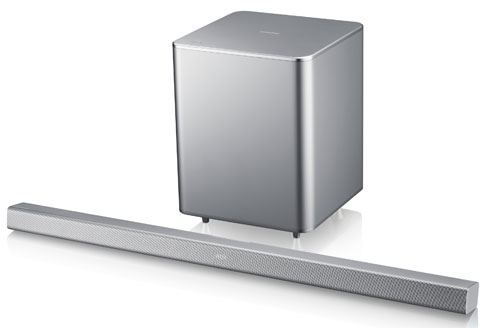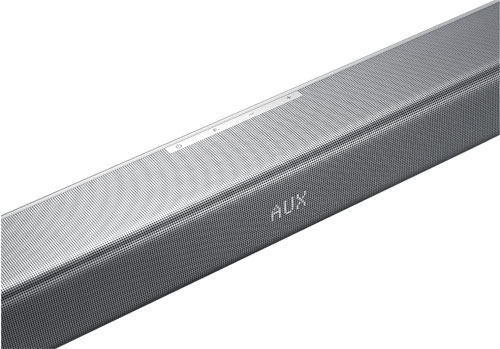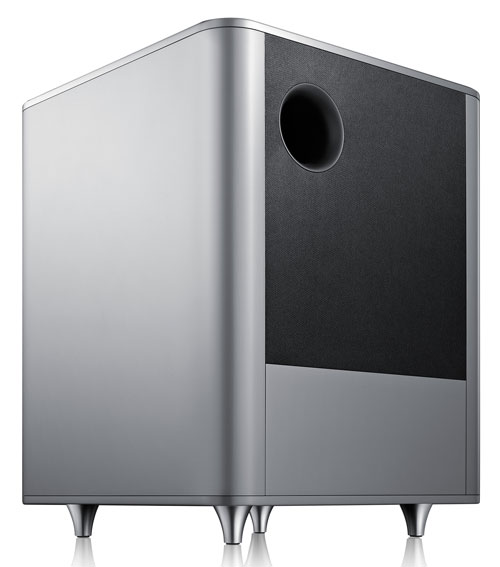The Samsung HW-F551 soundbar is the cheaper alternative to the HW-F751 we reviewed back in November. At a price of £279, it’s £150 less expensive, but does away with the Korean manufacturer’s valve technology, Virtual Surround feature, and auto calibration. So how does this translate to real-world listening? We’re about to find out…

Note: The specific unit we tested was the Samsung HW-F551/XU which is the silver, 3-pin plug UK version. An alternative Samsung HW-F550 model, is also available for buyers wanting a matching black finish for their flat-screen TV or viewing environment. Both should deliver similar acoustic performance given identical specifications except for the colour.
We’re pleased to report that the Samsung F551 shares all the same style qualities as its bigger brother even with the lower price tag. Finished once again in perforated aluminium, the HWF551 looks fantastic. The omission of the valve has halved the depth to just 60mm, and standing at just 55mm tall, this makes for one of the most compact soundbars currently available on the market. One of our favourite features on the step-up HW-F751 was the really cool LED display that was tucked away under the perforated mesh, and it’s great to see the same feature present on the F551.

One thing that is missing from the HW-F551 is the orientation sensor. If you remember, the Samsung F751 would recognise which position the soundbar was placed in and optimise the sound accordingly. However, not having this feature is hardly an issue: the slimline nature of the bar means that it sounds the same upright and on its back.

The Samsung HW-F551/ HW-F550 comes with exactly the same wireless subwoofer as the more expensive HW-F751/ HW-F750, which again lacks the stylistic grace found on the soundbar. The plastic enclosure just feels cheap compared to the solid metal casing of the soundbar. We’re not saying it’s awful-looking, it’s just not anything special. Looks aside, it’s wireless and connecting it with the soundbar was a breeze. As soon as it’s switched on, establishing a wireless connection was almost instant.
The Samsung HWF551 comes with an aux in, optical in, HDMI in, HDMI out and ARC (audio return channel). On the top of the bar there is also a USB slot which will play AAC, MP3, WAV, WMA, OGG, and FLAC files from your USB stick. The F551 also allows you to stream music via your smartphone or tablet via Bluetooth technology.
Once again Samsung HDTV owners will be able to connect their television wirelessly to the soundbar via Bluetooth with the SoundShare feature. For anyone who doesn’t own a Samsung display, the easiest setup is to connect your Blu-ray or DVD player to the soundbar, and then use an additional HDMI cable to output into the ARC HDMI on your telly. You can then connect any additional devices to your TV, and let the TV switch the sources and output the correct audio via the ARC HDMI to the soundbar.
Once set up, we wasted no time in putting the HW-F551 through its paces and on the whole it fared very well. As the Samsung F551 doesn’t have the auto-calibration feature, it’s important to adjust the subwoofer volume, as out of the box it was too loud, overpowering the soundbar. Thankfully, the HW-F551 allows you to adjust the sub volume independently using the remote, so using some familiar bass tracks and reference scenes we soon had a good blend between the subwoofer and the soundbar. It’s important to remember that a subwoofer shouldn’t draw attention to itself: it should just be there to help out in reproducing those deep low bass notes, so spending a few minutes to get the level right is essential to the overall listening experience.
The absence of the valve really wasn’t too much of an issue with films, as the Samsung reproduces movie soundtracks to great effect, and to our ears sounded almost identical to its more expensive big brother. Like the HW-F751. the HW-F551 offers up a fantastic soundstage with excellent dynamics. Dialogue is clear and precise even at low volumes, and always perfectly in sync. The impressive soundstage is helped out by a solid bass response, although just like the step-up F751, the HW-F551 subwoofer would stumble trying to reproduce the very low bass frequencies of movie soundtracks.
The Samsung HW-F551 has the same sound processing effects as the HW-F751, including “Music“, “Drama“, “Cinema“, “Sports“, “Games“, and “Off” which is the original sound with no added effects. These are all accessible via the [Sound Effect] button on the remote. As before, we had a listen to each one, but still preferred the original sound, and so turned all the effects off. Again there’s a [3D Sound Plus] option which is meant to add depth and spaciousness to the sound, but in reality it just sounded far too echoey, so we strongly recommend you leave it off.
We didn’t really miss the valve technology when listening to movie soundtracks, but we certainly did with music. At low levels everything sounded great, but as soon as the Samsung HW-F551 was pushed there was a lack of dynamics in the midrange – the sound became a bit harsh and lacked the warmth of the HW-F751. The bass was nice and tight, and even when pushed hard we heard none of the rattles we often come across with movie soundtracks. It seems that it’s just those really low frequency notes that the HWF551 doesn’t like. When we reviewed the F751, we thought that the valve didn’t add much warmth to recordings, but we were mistaken. Upon listening to the valveless Samsung F551, there was definitely something missing in the sound that the HWF751 had, and all we can think of is that it must be the valve, or lack thereof.
With a current street price of around £279, the HW-F551 offers fantastic value for money with a sonic performance almost as good as its higher-priced sibling, the HW-F751. So which one to go for? If you mainly use your soundbar to watch movies, then the Samsung HWF551/ HWF550 offers better value for money, as you’d be hard-pressed to notice the sound difference without the valve technology. However, if you listen to a lot of music, you’ll want the HWF751/HWF750, as the warmth the valve brings to recordings is undeniable. You will pay an extra £150 for the privilege though, so the choice is yours…
